Obviously, I’m not the first to build a model (or other representation) of the Zaku Kai. In designing my model, I’ve relied mainly upon the lineart, but I’ve also examined othe renditions of the design (or elements of it) in an attempt to identify how particular parts were done well or why particular parts went badly.
Original Lineart (by Izubuchi Yutaka)
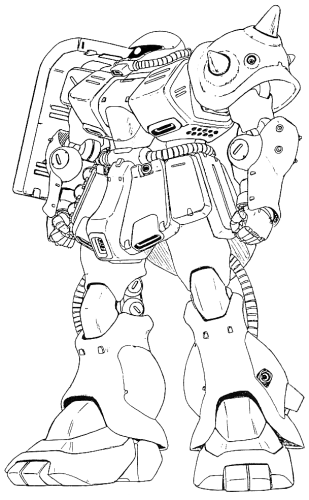 |
This is the definitive rendition of the Zaku Kai, drawn by Yutaka Izubuchi for use in the Gundam 0080 anime. In my early attempts to create plans for a Zaku Kai model I attempted to draw the Zaku freehand – and for a long time I couldn’t manage to get it to look right. Later I created plans by taking measurements directly from this lineart – this process helped me to better familiarize myself with the particulars of the design.
The Zaku Kai lineart is drawn in a perspective view and, I believe, contains a few inconsistencies and perspective errors: as a result I can’t create a model that matches this lineart perfectly. However, when I say I like the Zaku Kai, I’m speaking specifically of the lineart drawings. This is the design I want in model form, so I use the lineart as a reference where possible and in general as a goal. |
“Suku Suku Scratch” model (by Misaki Mitsuaki)
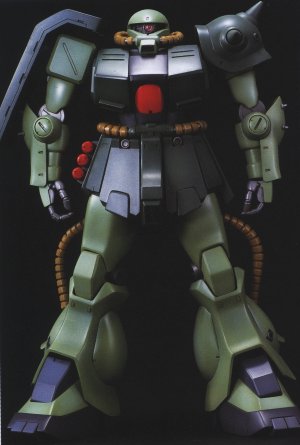 |
This model, which appeared in the Suku Suku Scratch article and the Gundam Scratchbuild Manual, is the best model of the Zaku Kai I’ve seen. There are a few areas I think could have been done differently: I feel like the shoulder armor is a bit small and the chest doesn’t quite convey the heft I want to see in the design. However, I feel that the end result here is a fantastic model – I aim to surpass this work, but I’d be happy enough to simply match it. I followed this build in the original Suku Suku Scratch articles back when I was just getting started in Gundam modeling: I found the work done on this model quite impressive and inspirational. A little intimidating, too, as the modeler not only built all the parts, but built many of them three or four times using different methods, and the results in each case matched each other. So while my progress on the project has been slow, it’s exciting to be at the stage where I feel I can match that feat. |
Hobby Japan “Gundam Weapons 0080” version (by Oseya Hiroshi)
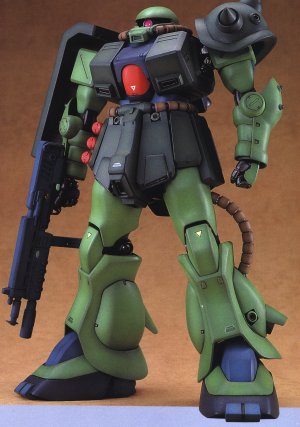 |
This model was a scratchbuilt conversion featured in Hobby Japan, based on the MG Zaku and MG Gouf. I’m not really happy with the look of this one, I feel like it went a bit astray due to the extensive use of pre-existing parts. I believe that when a modeler starts with a goal and a set of parts, the end result is a compromise, partially determined by their original goal and partially by whatever’s easy to build with the available parts.
It’s interesting to see the similarity between this model and Misaki’s model: arms, shoulders, and chest are all fairly similar, and yet I feel the end result is much different. Is the difference in effect just a result of the legs, head, and skirt of this model? It’s hard to say. I feel like this model is a reasonable attempt, but there are a number of specific areas that I feel are too far off-target and overall it doesn’t quite deliver the “Zaku Kai” effect. |
B-Club Zaku Kai conversion set (for MG Zaku F2)
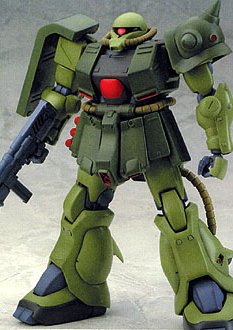 |
After the Gelgoog Jager kit I had high hopes for this conversion when I heard about it. It turned out to be a huge disappointment. It’s built on the MG Zaku-F2, which itself has a number of problems. This conversion set has a lot of resin parts, replacing entirely the feet, lower legs, chest, skirts, upper and lower arms, and so on. I guess the end result looks alright, but given the amount of resin I feel the end result should have been much better. |
Bandai 1:144 Zaku Kai
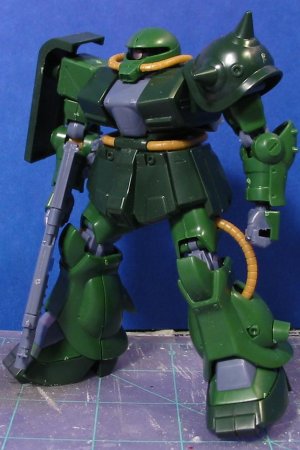 |
Bandai produced an injection-molded version of the Zaku Kai back in 1989 or so. It’s a reasonably good kit but features like the oversized head make it look reminiscent of the original Zaku kits produced in the early 1980’s. I see this kit as an example of how minor errors in the design adaptation can spoil the effect. I always thought that this kit looked as though the kit designers overestimated the Zaku’s bulk: everything is too wide. The kit can be improved significantly with just a little tweaking, however. |
Hajime Katoki’s MS-06FZ kit lineart & HGUC Zaku Kai
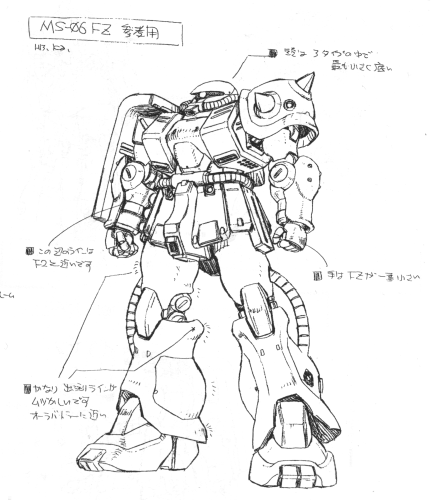 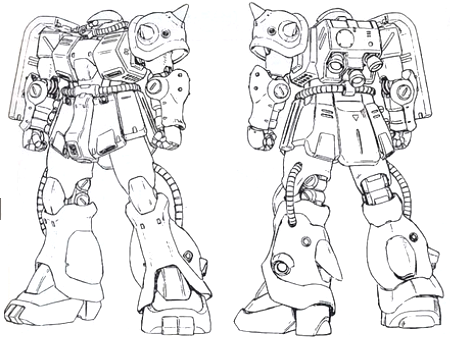 |
Long ago I learned of the existence of the first piece of lineart – some kind of draft or something done around the time of the MG Zaku F2 and HGUC Zaku designs. What I’d heard was that at the time Bandai was trying to establish MG designs not only for the Zaku F2, but for other Zaku designs which could be kitted on the same frame and using some of the same parts. The end result was that the MG Zaku F2 and HGUC Zaku were more alike than they should have been – and also the MG Zaku Kai lineart draft was created.
Anyway, fast-forward several years and we now have the HGUC Zaku Kai, based on a refined version of that same lineart.I’ve gone back and forth quite a bit in how I feel about the HGUC lineart and the kit itself – Ultimately, I would say that the lineart is prety close to the mark. At worst it suffers a little emaciation in the torso. The model, however, is rather different. Compared to the HGUC Zaku Kai lineart, the HGUC Zaku Kai itself has further reduced bulk in the legs and skirts, giving the kit a very lean look. I feel like it’s a nice, good-looking kit but it’s not what I’d call a “proper” Zaku Kai. It’s a slim version of a slim version of the original. |
Post a Comment